Business Research Method 1: Consumer Behavior for Airlines
VerifiedAdded on 2020/05/28
|7
|1368
|140
Report
AI Summary
This report presents a business research study focusing on consumer behavior within the airline industry, specifically comparing Full Service Carriers (FSCs) and Low Cost Carriers (LCCs). The research, conducted through a survey questionnaire, aims to identify the factors influencing customer choices and satisfaction. The questionnaire, composed of both closed-ended and open-ended questions, explores various aspects such as airfare, service quality, convenience, and demographic factors. The study highlights the importance of customer loyalty, brand image, and the differences between FSCs and LCCs. The report discusses the methodology, including the use of replicable scales, and the significance of the findings for airlines seeking to improve their market position. The conclusion emphasizes the role of customer experience and service delivery in influencing consumer decisions, providing insights for airlines to enhance their competitiveness through strategic improvements based on the survey's findings.
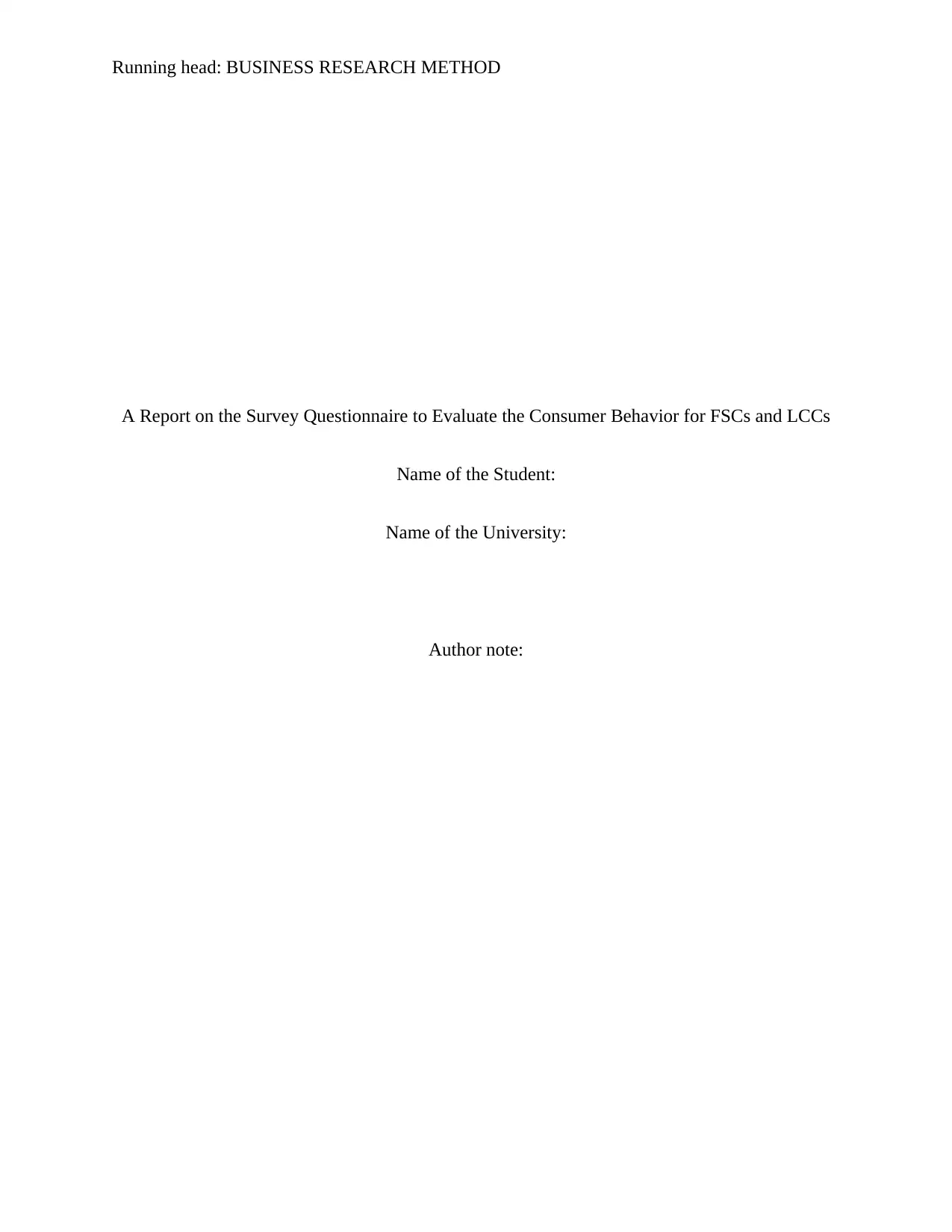
Running head: BUSINESS RESEARCH METHOD
A Report on the Survey Questionnaire to Evaluate the Consumer Behavior for FSCs and LCCs
Name of the Student:
Name of the University:
Author note:
A Report on the Survey Questionnaire to Evaluate the Consumer Behavior for FSCs and LCCs
Name of the Student:
Name of the University:
Author note:
Paraphrase This Document
Need a fresh take? Get an instant paraphrase of this document with our AI Paraphraser
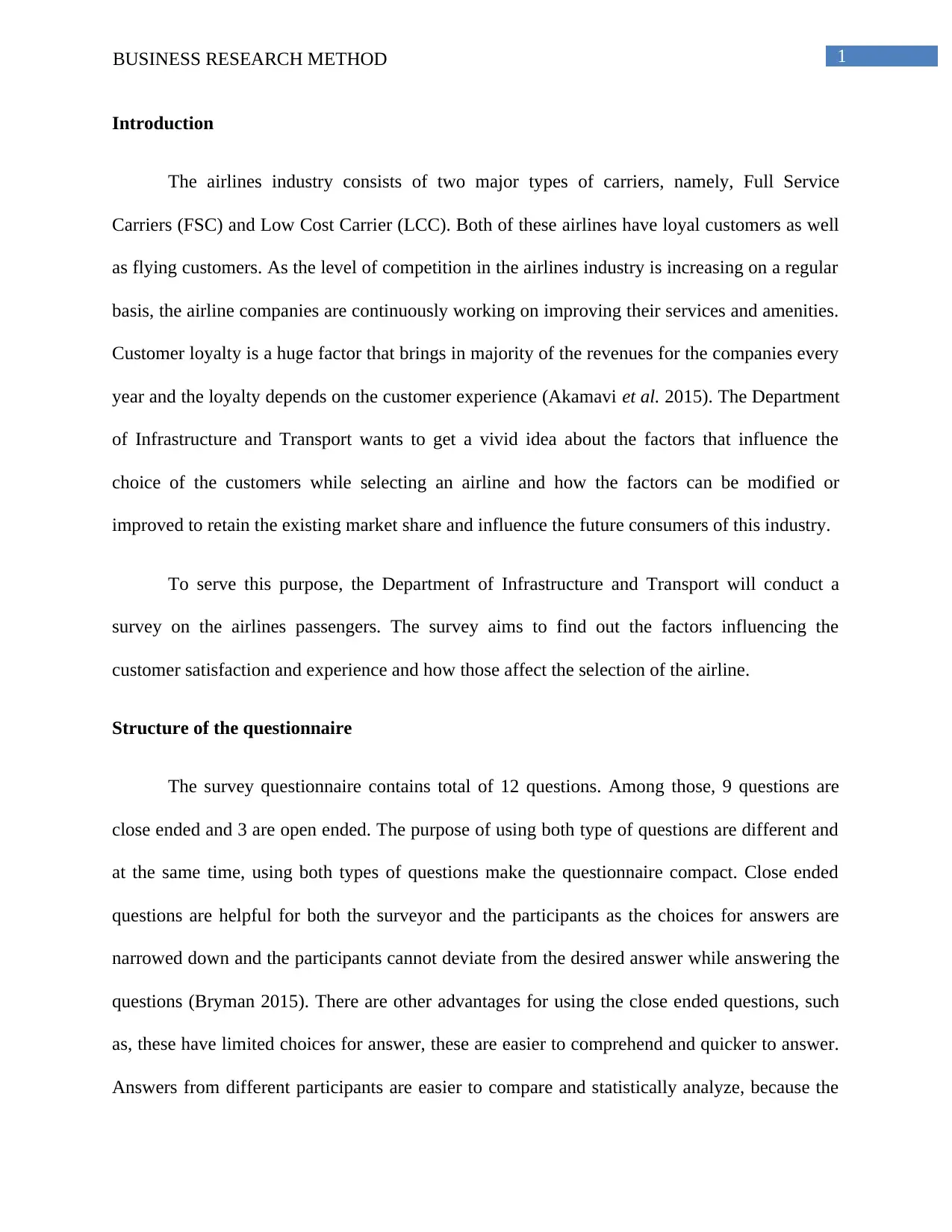
1BUSINESS RESEARCH METHOD
Introduction
The airlines industry consists of two major types of carriers, namely, Full Service
Carriers (FSC) and Low Cost Carrier (LCC). Both of these airlines have loyal customers as well
as flying customers. As the level of competition in the airlines industry is increasing on a regular
basis, the airline companies are continuously working on improving their services and amenities.
Customer loyalty is a huge factor that brings in majority of the revenues for the companies every
year and the loyalty depends on the customer experience (Akamavi et al. 2015). The Department
of Infrastructure and Transport wants to get a vivid idea about the factors that influence the
choice of the customers while selecting an airline and how the factors can be modified or
improved to retain the existing market share and influence the future consumers of this industry.
To serve this purpose, the Department of Infrastructure and Transport will conduct a
survey on the airlines passengers. The survey aims to find out the factors influencing the
customer satisfaction and experience and how those affect the selection of the airline.
Structure of the questionnaire
The survey questionnaire contains total of 12 questions. Among those, 9 questions are
close ended and 3 are open ended. The purpose of using both type of questions are different and
at the same time, using both types of questions make the questionnaire compact. Close ended
questions are helpful for both the surveyor and the participants as the choices for answers are
narrowed down and the participants cannot deviate from the desired answer while answering the
questions (Bryman 2015). There are other advantages for using the close ended questions, such
as, these have limited choices for answer, these are easier to comprehend and quicker to answer.
Answers from different participants are easier to compare and statistically analyze, because the
Introduction
The airlines industry consists of two major types of carriers, namely, Full Service
Carriers (FSC) and Low Cost Carrier (LCC). Both of these airlines have loyal customers as well
as flying customers. As the level of competition in the airlines industry is increasing on a regular
basis, the airline companies are continuously working on improving their services and amenities.
Customer loyalty is a huge factor that brings in majority of the revenues for the companies every
year and the loyalty depends on the customer experience (Akamavi et al. 2015). The Department
of Infrastructure and Transport wants to get a vivid idea about the factors that influence the
choice of the customers while selecting an airline and how the factors can be modified or
improved to retain the existing market share and influence the future consumers of this industry.
To serve this purpose, the Department of Infrastructure and Transport will conduct a
survey on the airlines passengers. The survey aims to find out the factors influencing the
customer satisfaction and experience and how those affect the selection of the airline.
Structure of the questionnaire
The survey questionnaire contains total of 12 questions. Among those, 9 questions are
close ended and 3 are open ended. The purpose of using both type of questions are different and
at the same time, using both types of questions make the questionnaire compact. Close ended
questions are helpful for both the surveyor and the participants as the choices for answers are
narrowed down and the participants cannot deviate from the desired answer while answering the
questions (Bryman 2015). There are other advantages for using the close ended questions, such
as, these have limited choices for answer, these are easier to comprehend and quicker to answer.
Answers from different participants are easier to compare and statistically analyze, because the
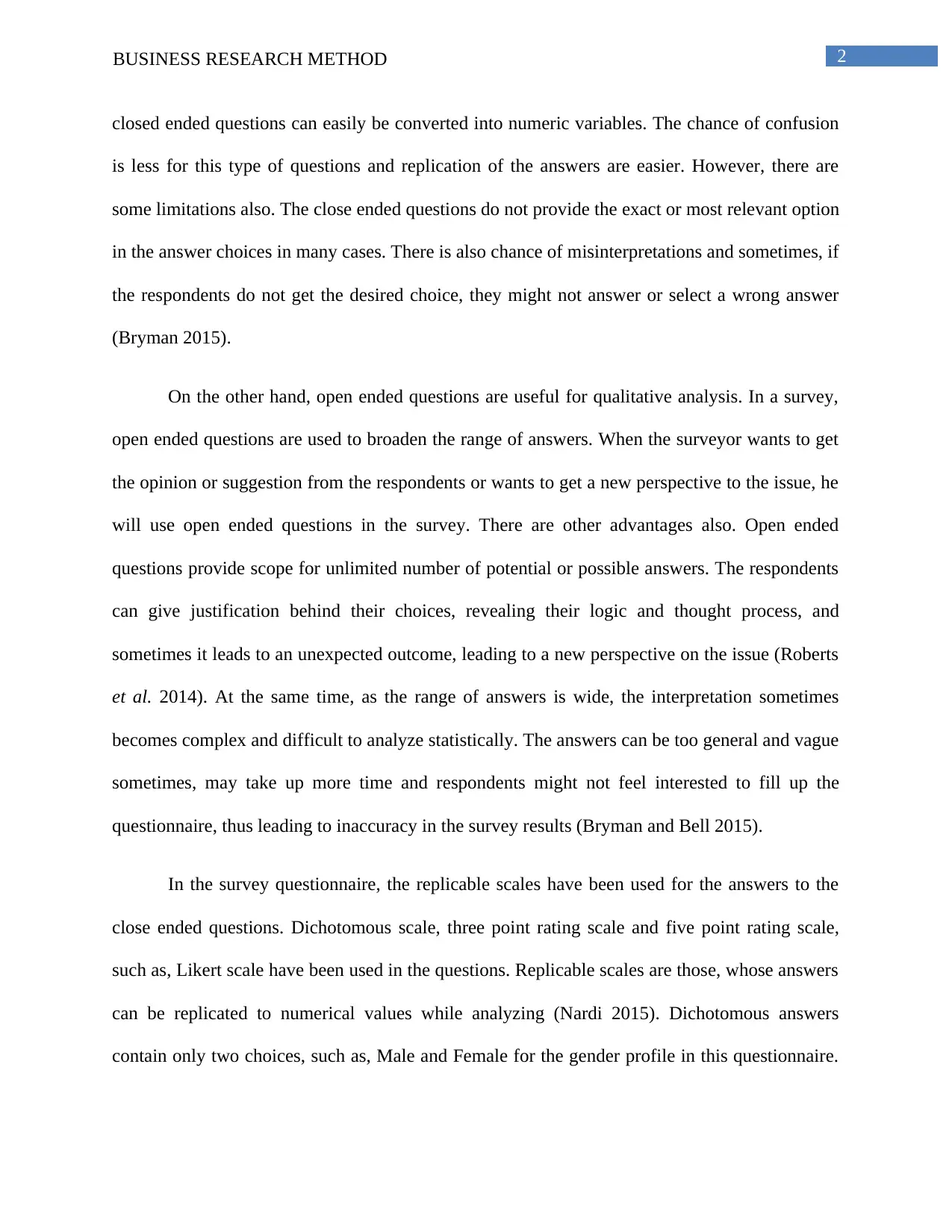
2BUSINESS RESEARCH METHOD
closed ended questions can easily be converted into numeric variables. The chance of confusion
is less for this type of questions and replication of the answers are easier. However, there are
some limitations also. The close ended questions do not provide the exact or most relevant option
in the answer choices in many cases. There is also chance of misinterpretations and sometimes, if
the respondents do not get the desired choice, they might not answer or select a wrong answer
(Bryman 2015).
On the other hand, open ended questions are useful for qualitative analysis. In a survey,
open ended questions are used to broaden the range of answers. When the surveyor wants to get
the opinion or suggestion from the respondents or wants to get a new perspective to the issue, he
will use open ended questions in the survey. There are other advantages also. Open ended
questions provide scope for unlimited number of potential or possible answers. The respondents
can give justification behind their choices, revealing their logic and thought process, and
sometimes it leads to an unexpected outcome, leading to a new perspective on the issue (Roberts
et al. 2014). At the same time, as the range of answers is wide, the interpretation sometimes
becomes complex and difficult to analyze statistically. The answers can be too general and vague
sometimes, may take up more time and respondents might not feel interested to fill up the
questionnaire, thus leading to inaccuracy in the survey results (Bryman and Bell 2015).
In the survey questionnaire, the replicable scales have been used for the answers to the
close ended questions. Dichotomous scale, three point rating scale and five point rating scale,
such as, Likert scale have been used in the questions. Replicable scales are those, whose answers
can be replicated to numerical values while analyzing (Nardi 2015). Dichotomous answers
contain only two choices, such as, Male and Female for the gender profile in this questionnaire.
closed ended questions can easily be converted into numeric variables. The chance of confusion
is less for this type of questions and replication of the answers are easier. However, there are
some limitations also. The close ended questions do not provide the exact or most relevant option
in the answer choices in many cases. There is also chance of misinterpretations and sometimes, if
the respondents do not get the desired choice, they might not answer or select a wrong answer
(Bryman 2015).
On the other hand, open ended questions are useful for qualitative analysis. In a survey,
open ended questions are used to broaden the range of answers. When the surveyor wants to get
the opinion or suggestion from the respondents or wants to get a new perspective to the issue, he
will use open ended questions in the survey. There are other advantages also. Open ended
questions provide scope for unlimited number of potential or possible answers. The respondents
can give justification behind their choices, revealing their logic and thought process, and
sometimes it leads to an unexpected outcome, leading to a new perspective on the issue (Roberts
et al. 2014). At the same time, as the range of answers is wide, the interpretation sometimes
becomes complex and difficult to analyze statistically. The answers can be too general and vague
sometimes, may take up more time and respondents might not feel interested to fill up the
questionnaire, thus leading to inaccuracy in the survey results (Bryman and Bell 2015).
In the survey questionnaire, the replicable scales have been used for the answers to the
close ended questions. Dichotomous scale, three point rating scale and five point rating scale,
such as, Likert scale have been used in the questions. Replicable scales are those, whose answers
can be replicated to numerical values while analyzing (Nardi 2015). Dichotomous answers
contain only two choices, such as, Male and Female for the gender profile in this questionnaire.
⊘ This is a preview!⊘
Do you want full access?
Subscribe today to unlock all pages.

Trusted by 1+ million students worldwide
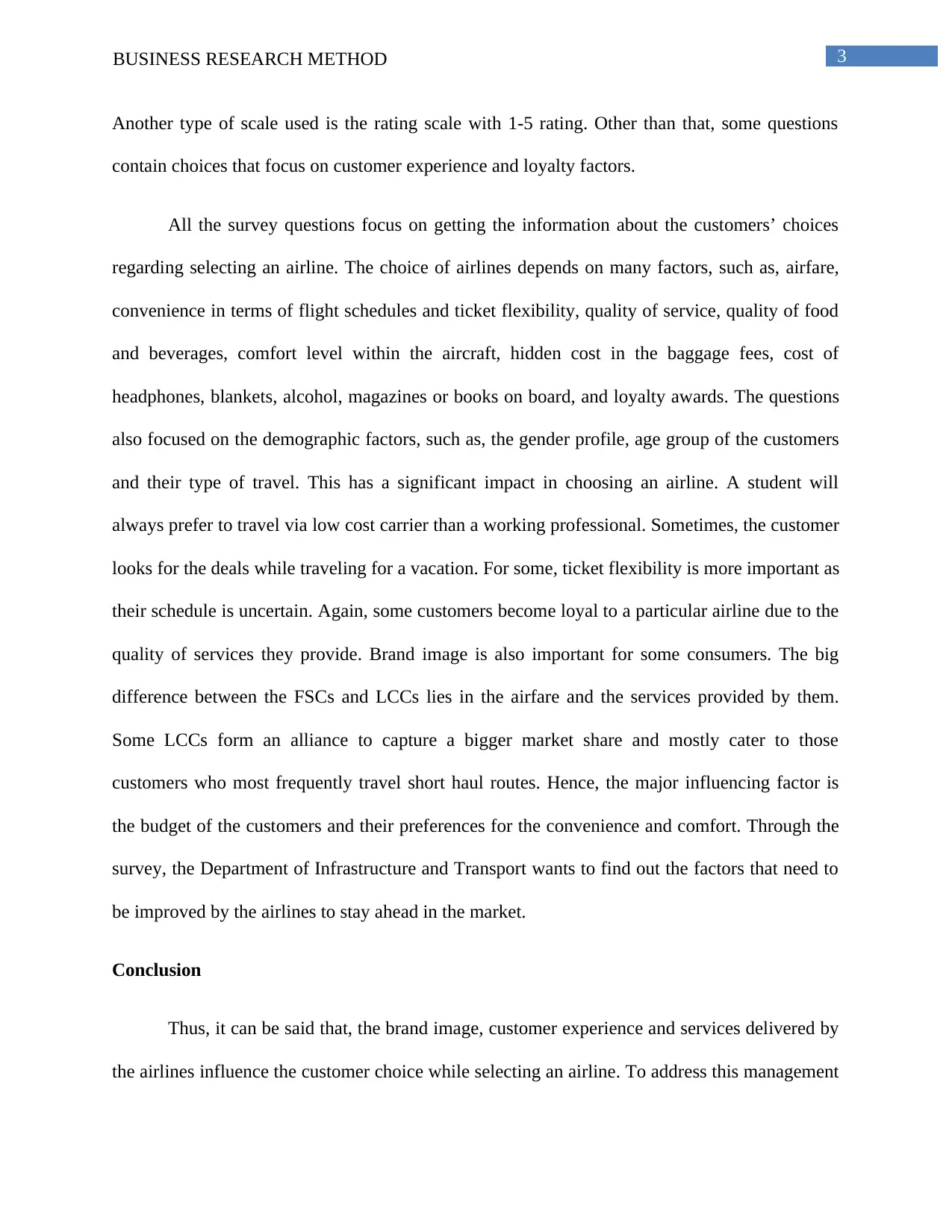
3BUSINESS RESEARCH METHOD
Another type of scale used is the rating scale with 1-5 rating. Other than that, some questions
contain choices that focus on customer experience and loyalty factors.
All the survey questions focus on getting the information about the customers’ choices
regarding selecting an airline. The choice of airlines depends on many factors, such as, airfare,
convenience in terms of flight schedules and ticket flexibility, quality of service, quality of food
and beverages, comfort level within the aircraft, hidden cost in the baggage fees, cost of
headphones, blankets, alcohol, magazines or books on board, and loyalty awards. The questions
also focused on the demographic factors, such as, the gender profile, age group of the customers
and their type of travel. This has a significant impact in choosing an airline. A student will
always prefer to travel via low cost carrier than a working professional. Sometimes, the customer
looks for the deals while traveling for a vacation. For some, ticket flexibility is more important as
their schedule is uncertain. Again, some customers become loyal to a particular airline due to the
quality of services they provide. Brand image is also important for some consumers. The big
difference between the FSCs and LCCs lies in the airfare and the services provided by them.
Some LCCs form an alliance to capture a bigger market share and mostly cater to those
customers who most frequently travel short haul routes. Hence, the major influencing factor is
the budget of the customers and their preferences for the convenience and comfort. Through the
survey, the Department of Infrastructure and Transport wants to find out the factors that need to
be improved by the airlines to stay ahead in the market.
Conclusion
Thus, it can be said that, the brand image, customer experience and services delivered by
the airlines influence the customer choice while selecting an airline. To address this management
Another type of scale used is the rating scale with 1-5 rating. Other than that, some questions
contain choices that focus on customer experience and loyalty factors.
All the survey questions focus on getting the information about the customers’ choices
regarding selecting an airline. The choice of airlines depends on many factors, such as, airfare,
convenience in terms of flight schedules and ticket flexibility, quality of service, quality of food
and beverages, comfort level within the aircraft, hidden cost in the baggage fees, cost of
headphones, blankets, alcohol, magazines or books on board, and loyalty awards. The questions
also focused on the demographic factors, such as, the gender profile, age group of the customers
and their type of travel. This has a significant impact in choosing an airline. A student will
always prefer to travel via low cost carrier than a working professional. Sometimes, the customer
looks for the deals while traveling for a vacation. For some, ticket flexibility is more important as
their schedule is uncertain. Again, some customers become loyal to a particular airline due to the
quality of services they provide. Brand image is also important for some consumers. The big
difference between the FSCs and LCCs lies in the airfare and the services provided by them.
Some LCCs form an alliance to capture a bigger market share and mostly cater to those
customers who most frequently travel short haul routes. Hence, the major influencing factor is
the budget of the customers and their preferences for the convenience and comfort. Through the
survey, the Department of Infrastructure and Transport wants to find out the factors that need to
be improved by the airlines to stay ahead in the market.
Conclusion
Thus, it can be said that, the brand image, customer experience and services delivered by
the airlines influence the customer choice while selecting an airline. To address this management
Paraphrase This Document
Need a fresh take? Get an instant paraphrase of this document with our AI Paraphraser
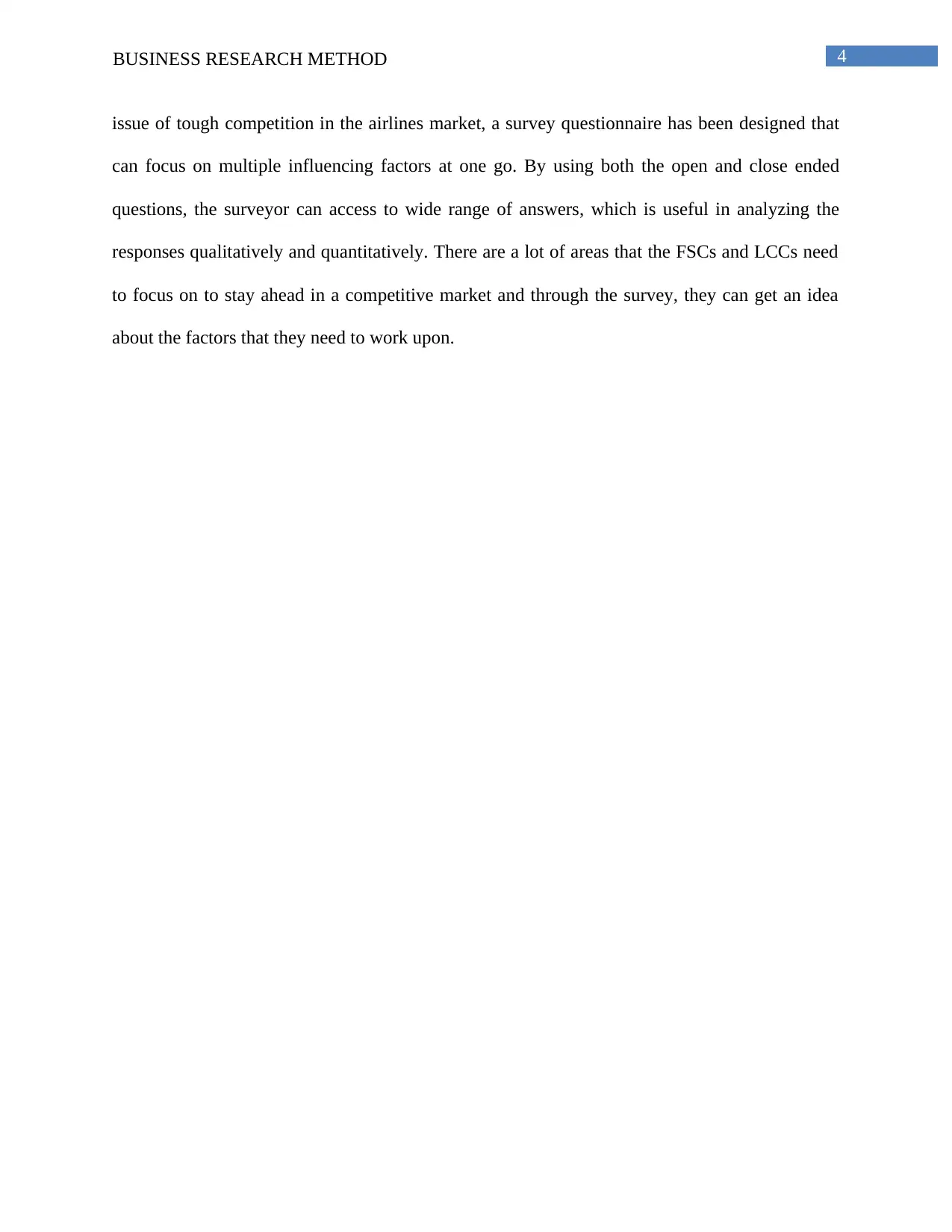
4BUSINESS RESEARCH METHOD
issue of tough competition in the airlines market, a survey questionnaire has been designed that
can focus on multiple influencing factors at one go. By using both the open and close ended
questions, the surveyor can access to wide range of answers, which is useful in analyzing the
responses qualitatively and quantitatively. There are a lot of areas that the FSCs and LCCs need
to focus on to stay ahead in a competitive market and through the survey, they can get an idea
about the factors that they need to work upon.
issue of tough competition in the airlines market, a survey questionnaire has been designed that
can focus on multiple influencing factors at one go. By using both the open and close ended
questions, the surveyor can access to wide range of answers, which is useful in analyzing the
responses qualitatively and quantitatively. There are a lot of areas that the FSCs and LCCs need
to focus on to stay ahead in a competitive market and through the survey, they can get an idea
about the factors that they need to work upon.
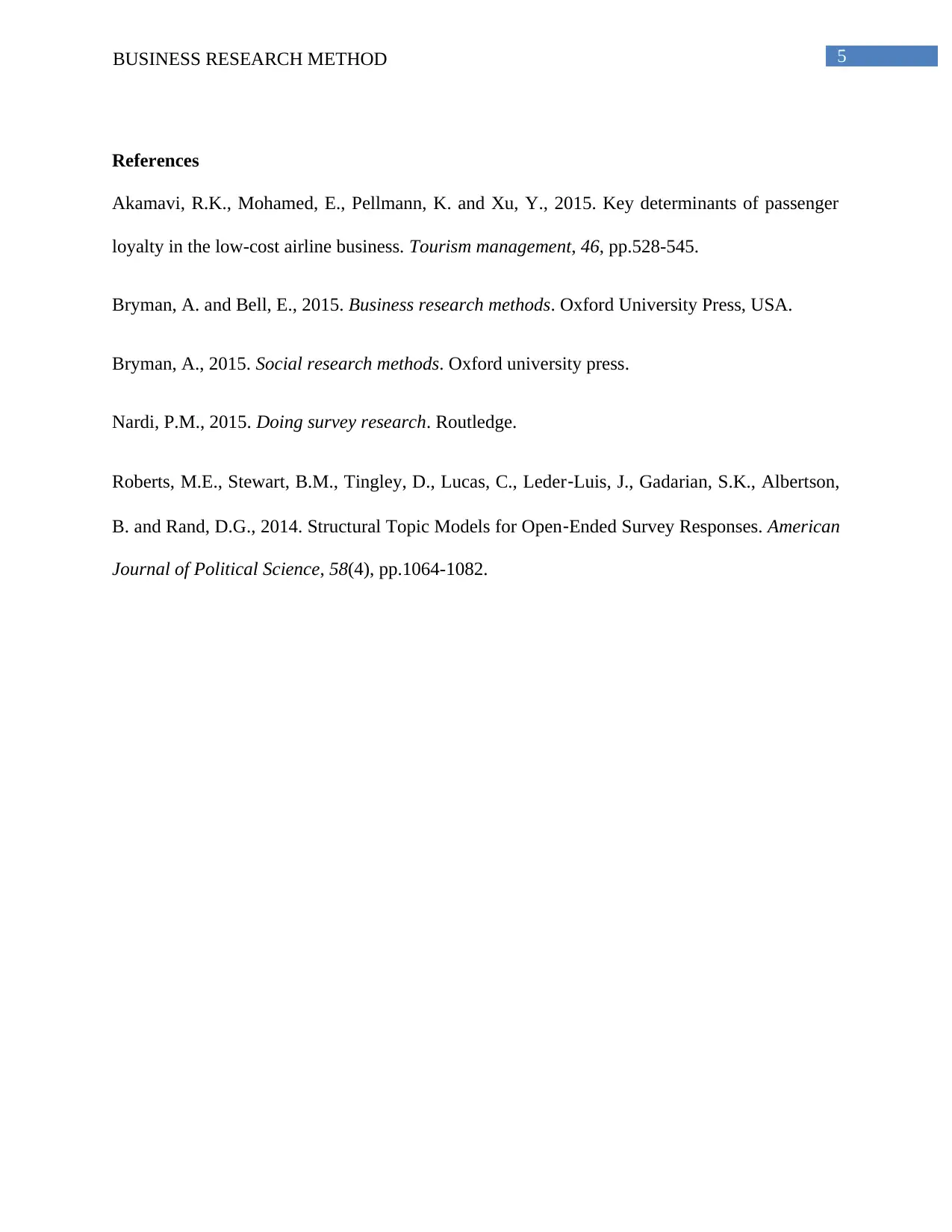
5BUSINESS RESEARCH METHOD
References
Akamavi, R.K., Mohamed, E., Pellmann, K. and Xu, Y., 2015. Key determinants of passenger
loyalty in the low-cost airline business. Tourism management, 46, pp.528-545.
Bryman, A. and Bell, E., 2015. Business research methods. Oxford University Press, USA.
Bryman, A., 2015. Social research methods. Oxford university press.
Nardi, P.M., 2015. Doing survey research. Routledge.
Roberts, M.E., Stewart, B.M., Tingley, D., Lucas, C., Leder‐Luis, J., Gadarian, S.K., Albertson,
B. and Rand, D.G., 2014. Structural Topic Models for Open‐Ended Survey Responses. American
Journal of Political Science, 58(4), pp.1064-1082.
References
Akamavi, R.K., Mohamed, E., Pellmann, K. and Xu, Y., 2015. Key determinants of passenger
loyalty in the low-cost airline business. Tourism management, 46, pp.528-545.
Bryman, A. and Bell, E., 2015. Business research methods. Oxford University Press, USA.
Bryman, A., 2015. Social research methods. Oxford university press.
Nardi, P.M., 2015. Doing survey research. Routledge.
Roberts, M.E., Stewart, B.M., Tingley, D., Lucas, C., Leder‐Luis, J., Gadarian, S.K., Albertson,
B. and Rand, D.G., 2014. Structural Topic Models for Open‐Ended Survey Responses. American
Journal of Political Science, 58(4), pp.1064-1082.
⊘ This is a preview!⊘
Do you want full access?
Subscribe today to unlock all pages.

Trusted by 1+ million students worldwide
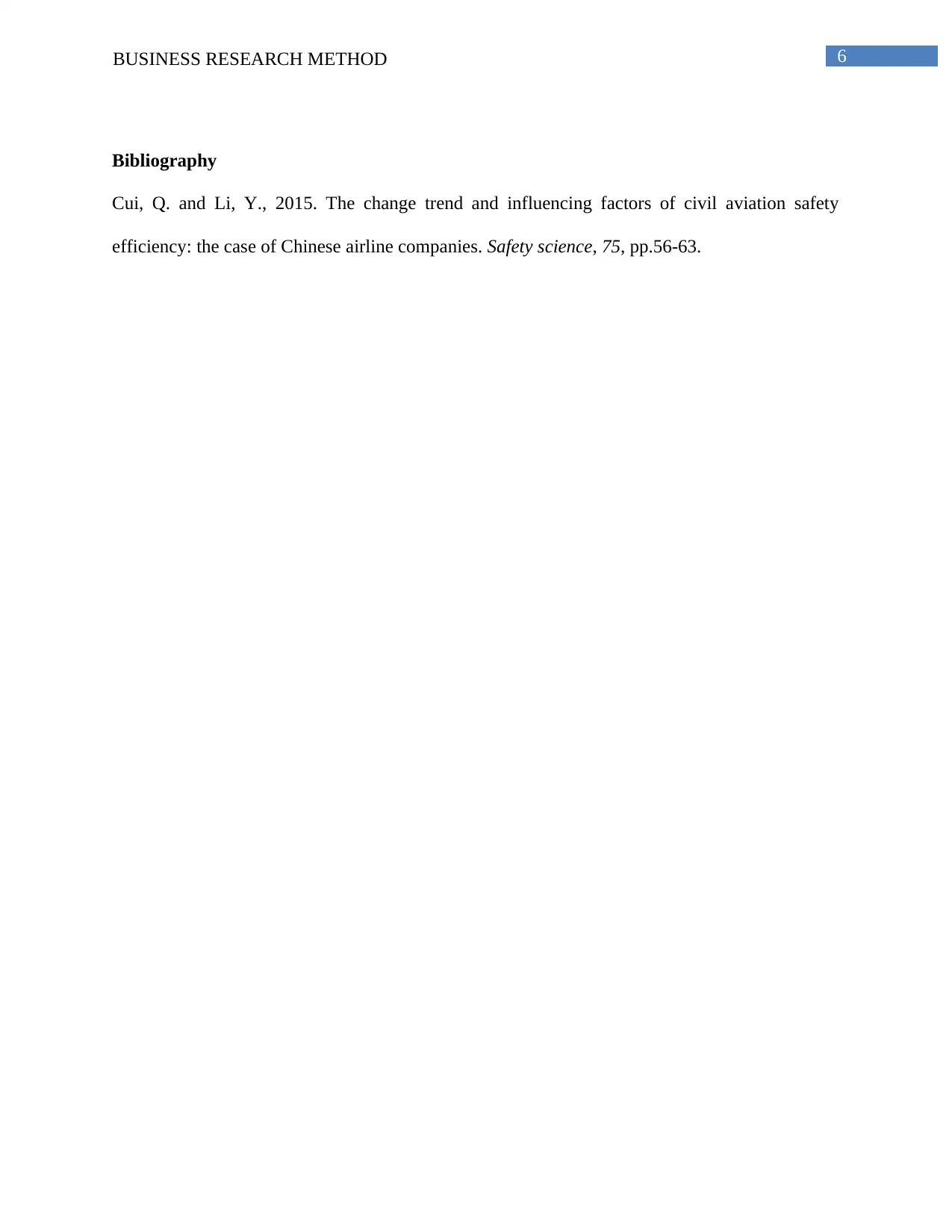
6BUSINESS RESEARCH METHOD
Bibliography
Cui, Q. and Li, Y., 2015. The change trend and influencing factors of civil aviation safety
efficiency: the case of Chinese airline companies. Safety science, 75, pp.56-63.
Bibliography
Cui, Q. and Li, Y., 2015. The change trend and influencing factors of civil aviation safety
efficiency: the case of Chinese airline companies. Safety science, 75, pp.56-63.
1 out of 7
Related Documents
Your All-in-One AI-Powered Toolkit for Academic Success.
+13062052269
info@desklib.com
Available 24*7 on WhatsApp / Email
![[object Object]](/_next/static/media/star-bottom.7253800d.svg)
Unlock your academic potential
Copyright © 2020–2025 A2Z Services. All Rights Reserved. Developed and managed by ZUCOL.





